Sulfur Chemiluminescence Detector(SCD)
In a sulfur chemiluminescence detector (SCD), samples (sulfur compounds) eluted from a GC column are injected into a burner to cause oxidation and reduction reactions. Then the samples (SO radicals) are sent to a reaction cell, where they collide with ozone, which generates light emission that is detected by a photomultiplier. According to the measuring principle, SCD is sensitive only to sulfur compounds and can selectively detect trace amounts of sulfur compounds in complex sample matrixes.
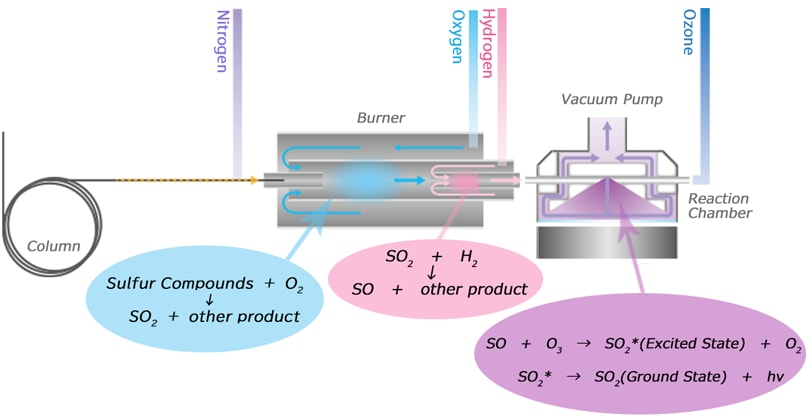
Reference:Robert L. Grob PhD , Eugene F. Barry PhD (2004)Modern practice of gas chromatography, 4th edition. Wiley-Interscience
SCD with Proprietary Shimadzu Technology
The SCD-2030 is a sulfur chemiluminescence detector (SCD) based on Shimadzu’s proprietary detection method. With dramatically higher sensitivity and stability, excellent maintainability, and the first in the industry to include automation functionality, the SCD-2030 will improve laboratory productivity.
Feature 1: Ultra-Short Flow Path Due to the Industry’s First Horizontal Burner Orientation
Because the burner must be connected to the GC column, it is conventionally positioned above the GC oven in a vertical orientation. However, the Shimadzu development team discovered that the vertical orientation results in a longer path between the burner and reaction chamber, which decreases detection sensitivity.
Therefore, the burner in the SCD-2030 is oriented horizontally (Patent pending). That breakthrough results in a much shorter path length between the burner and reaction chamber than in conventional products. That feature is referred to as an ultra-short flow path.
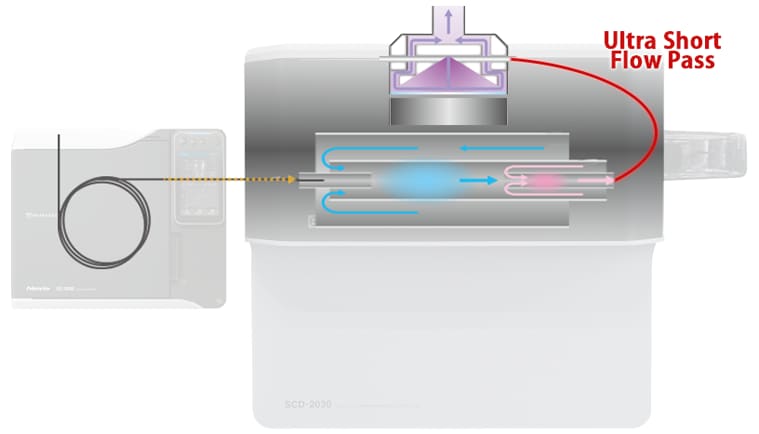
To ensure the unique horizontal burner configuration in the SCD-2030 is protected, design rights are being secured in countries throughout the world. (Regeistered Design: JP01633437,CN 201930053585.7 ,EU006260642,KR30-1036711, US:D895462)
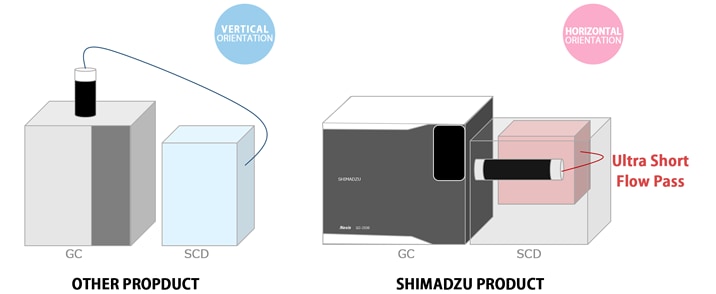
![]() PCT/JP2019/002999、PCT/JP 2019/035192
PCT/JP2019/002999、PCT/JP 2019/035192
Furthermore, the SCD-2030 can be set up either in the left or right of the GC because the burner in the SCD-2030 is oriented horizontally.

Feature 2: Innovative Modifications to the Inlet Tube and Inside the Burner
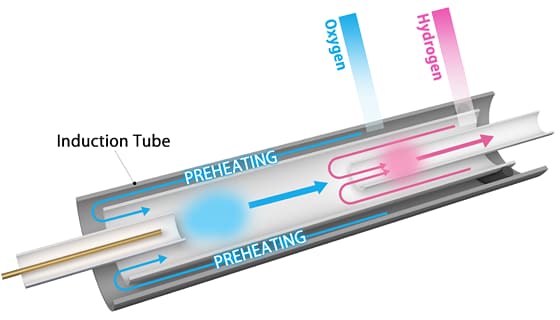
- ●Induction Tube:
- In addition to the inner and outer pyro-tubes included in conventional designs, a new induction tube was also added to create a triple-tube burner structure (Patent pending). With the triple-tube structure, the oxygen can be preheated before entering the reaction zone, which succeeds in eliminating impurities in oxygen and increasing oxidation capacity.
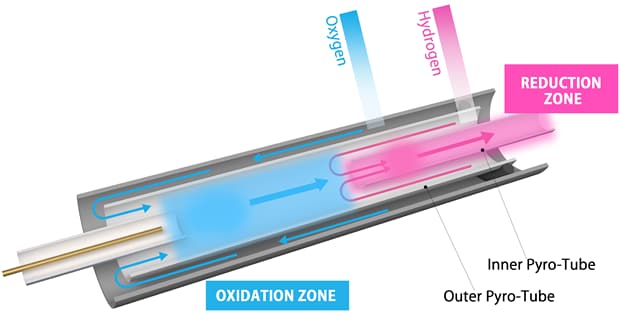
- ●Outer Pyro-Tube & Inner Pyro-Tube:
- The outer pyro-tube is longer than in conventional designs combining the outer pyro-tube with the inner pyro-tube, which provides a larger reaction zone for oxidation and reduction reactions, allows a sufficient redox reaction of the sample. Configuring the longer tube was made possible by the horizontal orientation in Feature 1. It contributes to high stability analysis results in the analysis of hydrocarbon matrix samples and analysis methods which use high column flow rates.
 PCT/JP2018/047046
PCT/JP2018/047046
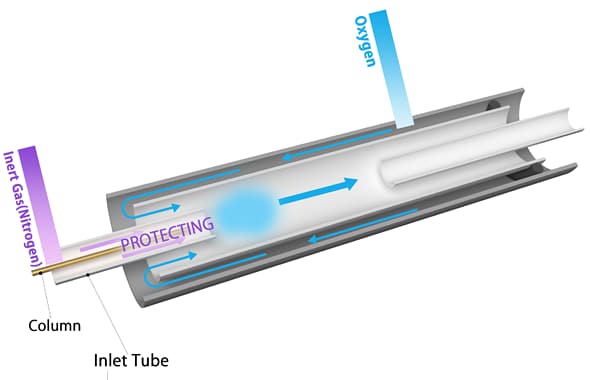
- ●Inlet Tube:
- An inert atmosphere area is included to protect the column outlet from high temperatures inside the burner. That inert area is achieved by injecting inert gas into an inlet tube installed where the column is inserted (Patent pending). It prevents column bleeding caused by the column being exposed to oxygen in a high-temperature environment. (Column bleeding is a phenomenon where decomposition products from the column stationary phase leach out to negatively affect detection results.)
Furthermore, the burner is temperature-controlled to a high temperature, so that reaction heat increases the temperature to 1800 °C in the area where oxidation and reduction reactions occur. Heat expansion caused by that high temperature, particularly in the outer pyro-tube, can make it difficult to maintain a fixed state.
SCD-2030 uses a single O-ring to hold the outer pyro-tube in place. Therefore, the O-ring absorbs the effects of heat expansion to successfully hold the outer pyro-tube in a stable position. That technology is only possible due to the induction tube used in SCD-2030 systems.
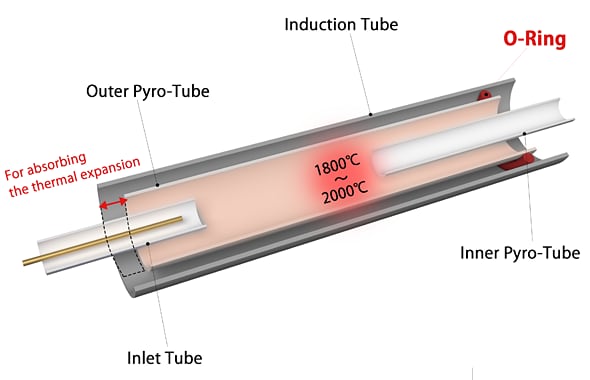
Feature 3: Reaction Chamber Design
In the SCD, sample reaction products from the burner are transported to the reaction chamber, where they collide with ozone. Then the amount of light emission from those collisions is detected by a photomultiplier and used to determine the quantity of sulfur in the sample.
Conventional designs involve a reaction between SO and ozone only in the reaction chamber, but the SCD-2030 is shaped to retain the post-reaction excited-state SO2 radicals in the reaction chamber for a longer time. That increases detection sensitivity by providing more time for the photomultiplier to detect light emission.
SCD(Previous product)
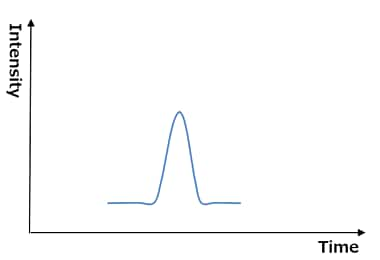
SCD-2030(Shimadzu product)
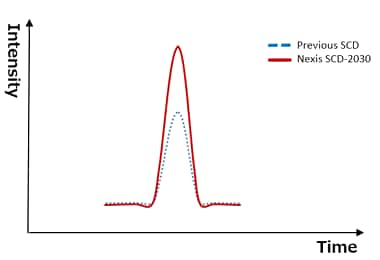
Feature 4: The Industry's First Automation Functionality
The SCD is the first product in the industry to offer functionality for automating the complicated preparation steps before samples can be analyzed (Patent pending). Using the SCD involves a series of startup steps that enable the burner and reaction chamber to be used for analysis. Performing those steps in the wrong sequence or incorrectly could prevent accurate measurements or damage part of the instrument.
The automation functionality includes features designed based on our engineers’ desire to offer instruments that can be operated even by non-experts.

![]() PCT/JP2019/003679、Japanese Patent Application No. 2019-017208
PCT/JP2019/003679、Japanese Patent Application No. 2019-017208
Various Benefits Provided by Shimadzu’s Proprietary Technology
World’s Highest Sensitivity Level
SO radicals generated by a burner are very unstable substances. Delivering the radicals to the reaction chamber more quickly helps prevent sensitivity losses, which results in 2.5 times higher sensitivity than existing products.
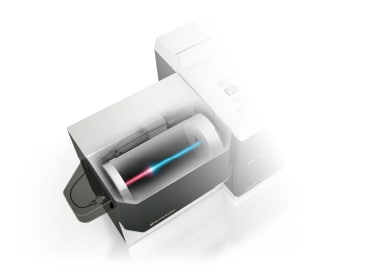
Highly Stable Analysis
Providing ample reaction time and a reaction zone within the cell promotes the sample’s oxidation-reduction reaction. Positioning the burner beside the oven avoids generating convection between the burner and hot oven. That enables highly stable analysis, even if samples are injected through the column at high flowrates.
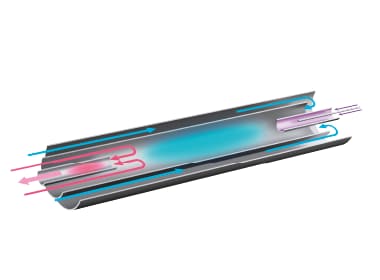
Easier Maintenance
Accessibility was improved to the inner pyro-tube, which requires regular maintenance. That has significantly shortened the time required to replace the inner pyro- tube, which previously had been a problem.
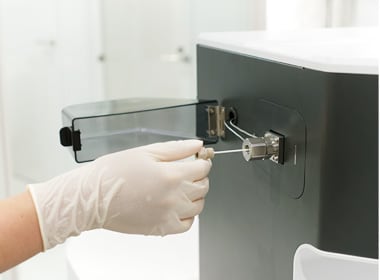
- Analysis Example:
- Analysis of Thiophene in Benzene: Comparison of FPD(S) and SCD Analyses
- Analysis of Trace Thiophene in Benzene According to ASTM D7011 Using Nexis™ SCD-2030
- Analysis of Sulfur Compounds in Natural Gas by Nexis SCD-2030 According to ASTM D5504
- Performance Assessment of Nexis™ SCD-2030 Using Sulfur Compounds Recommended by ASTM D5623
- Analysis of Volatile Sulfur Compounds in Beer Using Nexis™ SCD-2030
- New Approach to Food Smell Analysis Using Combination of GCMS™ and GC-SCD (2)
- New Approach to Food Smell Analysis Using Combination of GCMS™ and GC-SCD (1)



